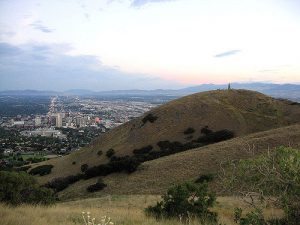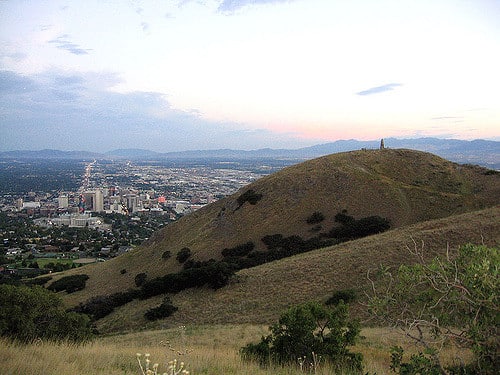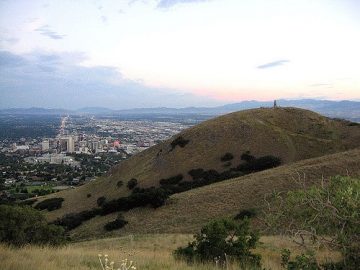
By Argyleist
I would begin this Relief Society lesson with this quote from the manual:
“I believe and testify that it is the mission of this church to stand as an ensign to the nations and a light to the world. We have had placed upon us a great, all-encompassing mandate from which we cannot shrink nor turn aside. We accept that mandate and are determined to fulfill it.”
What is an ensign? Merriam-Webster says, “:a flag that is flown (as by a ship) as the symbol of nationality and that may also be flown with a distinctive badge added to its design.”
How did we come to use this analogy of a flag or ensign?
On July 24, 1847, the pioneer company of our people came into [the Salt Lake] valley. An advance group had arrived a day or two earlier. Brigham Young arrived on Saturday. The next day, Sabbath services were held both in the morning and in the afternoon…The next morning they divided into groups to explore their surroundings. Brigham Young, Wilford Woodruff, and a handful of their associates hiked from their campground…They climbed a dome-shaped peak, President Young having difficulty because of his recent illness.
When the Brethren stood on the summit, they looked over [the] valley to the south of them. It was largely barren, except for the willows and rushes that grew along the streams that carried water from the mountains to the lake. There was no building of any kind, but Brigham Young had said the previous Saturday, “This is the place.”
The summit where they stood was named Ensign Peak out of reference to these great prophetic words of Isaiah: “And he [speaking of God] will lift up an ensign to the nations from far, and will hiss unto them from the end of the earth: and, behold, they shall come with speed swiftly.” (Isa. 5:26)
“And he shall set up an ensign for the nations, and shall assemble the outcasts of Israel, and gather together the dispersed of Judah from the four corners of the earth.” (Isa. 11:12)
How foolish, someone might have said, had he heard these men that July morning in 1847. They did not look like statesmen with great dreams. They did not look like rulers poring over maps and planning an empire. They were exiles, driven from their fair city on the Mississippi [River] into this desert region of the West. But they were possessed of a vision drawn from the scriptures and words of revelation.
I marvel at the foresight of that little group. It was both audacious and bold. It was almost unbelievable. Here they were, almost a thousand miles [1,600 kilometers] from the nearest settlement to the east and almost eight hundred miles [1,300 kilometers] from the Pacific Coast. They were in an untried climate. The soil was different from that of the black loam of Illinois and Iowa, where they had most recently lived. They had never raised a crop here. They had never experienced a winter. They had not built a structure of any kind. These prophets, dressed in old travel-worn clothes, standing in boots they had worn for more than a thousand miles from Nauvoo to this valley, spoke of millennial vision. They spoke out of a prophetic view of the marvelous destiny of this cause. They came down from the peak that day and went to work to bring reality to their dreams. GBH Manual
How do you think Brigham Young and the others felt, looking over the valley with the vision they had for what it would become? How do you feel in your own life when you can see the whole grand vision of something great that you are working on with God? What did these early pioneers do after they stood on the mountain with their grand vision? What is the relationship between visioning, seeing the whole picture, and coming down from the mountain to work on the minute details that propel us toward fulfilling the vision?
Sometimes in our day, as we walk our narrow paths and fill our little niches of responsibility, we lose sight of the grand picture. When I was a small boy, draft horses were common. An important part of the harness was the bridle. On the bridle were blinders, one on each side. They were so placed that the horse could see only straight ahead and not to either side. They were designed to keep him from becoming frightened or distracted and to keep his attention on the road at his feet.
Some of us do our work as if we had blinders on our eyes. We see only our own little narrow track. We catch nothing of the broader vision.
While grubbing the sagebrush of these western valleys [of Utah] to lay the foundations for a commonwealth, while doing all of the many mundane things they were required to do to stay alive and grow, our [pioneer] forebears ever kept before them the grandeur of the great cause in which they were engaged. It is a work which we must do with the same vision they held. It is a work which will go on after we have left this scene. God help us to do our very best as servants, called under His divine will, to carry forward and build the kingdom with imperfect hands, united together to execute a perfect pattern. GBH Manual
As we begin a new year, how can we broaden the vision we have of the work we are doing in our individual lives? How can this help us to be an ensign or a light to the world? An ensign usually has a symbol or emblem to signify something about the people or place that the ensign represents. What is your emblem that you want the world to see? Some thoughts might include love, charity, light, joy, simplicity, determination, forgiveness, peace… As I have thought about this lesson and the beginning of a new year, I want the emblem on my flag to be grace. I have felt the presence of God’s grace so fully in my life, and I want to become the presence of grace for others. I want to turn every social interaction I have into something beautiful and graceful. You could ask individuals in the class to think of what they want the emblem of their ensign to be this year.
Gordon B. Hinckley mentioned in the quote above that the effort of the pioneers in creating and working toward their vision was audacious and bold. What does this mean and how can we be audacious and bold in our individual visions?
This is a season to be strong. It is a time to move forward without hesitation, knowing well the meaning the breadth, and the importance of our mission. It is a time to do what is right regardless of the consequences that might follow…It is a season to reach out with kindness and love to those in distress and to those who are wandering in darkness and pain. It is a time to be considerate and good, decent and courteous toward one another in all of our relationships.
If we are to hold up this Church as an ensign to the nations and a light to the world, we must take on more of the luster of the life of Christ individually and in our own personal circumstances. In standing for the right, we must not be fearful of the consequences. We must never be afraid. Said Paul to Timothy:
“For God hath not given us the spirit of fear; but of power, and of love, and of a sound mind.
Be not thou therefore ashamed of the testimony of our Lord” (2 Timothy 1:7-8) GBH Manual
Boldness means we love when it’s hard. It means that we choose power, love, and a sound mind instead of fear. It means that we choose to do what is right, even when there are heavy consequences. What are some of your insights from the above passages?
Sometimes boldness and audacity can be conflated with arrogance. How do we distinguish the difference?
Let us glory in this wonderful season of the work of the Lord. Let us not be proud or arrogant. Let us be humbly grateful. And let us, each one, resolve within himself or herself that we will add to the luster of this magnificent work of the Almighty, that it may shine across the earth as a beacon of strength and goodness for all the world to look upon. GBH Manual
Sometimes the idea of choosing to be a light to the world can lead to the rhetoric of the rest of the world being in darkness. Sometimes the idea of boldly visioning and holding up an ensign to represent who we are can leave us with an us vs. them mentality. Flags are often used to represent a division of people and land. Using our ensign as a divisive measure will only lead to more fear and less love.
As President Aileen H. Clyde said, “[W]e may be turned by fear to looking for protection from one another rather than keeping our promise to be a light and a protection for one another.” Aileen H. Clyde, Relief Society Presidency “Covenant of Love.” Ensign, May 1995
How can our ensign be different? We each have unique things to offer the world. When we choose the love, power, and light that President Hinckley mentioned, our ensign will be less of a bold pronouncement about how we stand out from others, and more of a way to give ourselves and our individual gifts to the world. It will be a way to let others know that we are the light and love of Christ, that we are a safe place. Our light will add to the luster that is already out in the world. Our ensign will unite rather than divide.
President Bonnie L. Oscarson said:
If there are barriers, it is because we ourselves have created them. We must stop concentrating on our differences and look for what we have in common; then we can begin to realize our greatest potential and achieve the greatest good in this world. Sister Marjorie P. Hinckley once said, “Oh, how we need each other. Those of us who are old need you who are young, and hopefully, you who are young need some of us who are old. It is a sociological fact that women need women. We need deep and satisfying and loyal friendships with each other. Sister Hinckley was right; oh, how we need each other!
Sisterhood: Oh, How We Need Each Other; April 2014 Ensign; Bonnie L. Oscarson
Patricia T. Holland said:
Obviously the Lord has created us with different personalities, as well as differing degrees of energy, interest, health, talent, and opportunity. So long as we are committed to righteousness and living a life of faithful devotion, we should celebrate those divine differences, knowing they are a gift from God. We must not feel so frightened and insecure; we must not need to find exact replicas of ourselves in order to feel validated as women of worth. There are many things over which we can be divided, but one thing is needful for our unity—the empathy and compassion of the living Son of God.
“One Thing Needful: Becoming a Woman of Greater Faith in Christ;” October 1987; Patricia T. Holland
As we embrace the empathy and compassion of Christ as Sister Holland says, we will be able to hold up an ensign of light, unity, and love. When we boldly create broad visions with God’s help, and work hard at the daily tasks that lead us to fulfill our visions. our lives will add to the light of the world. This would be a good opportunity to ask the sisters if they have anything else they want to share about visions they have and the work they are doing to fulfill those visions and send their light into the world.




9 Responses
This is terrific. I love so many of these quotes! Thanks, Jenny.
So great, thank you for sharing your thoughts! Did anyone do one for GBH Chapter 1? I can’t find any thing for Chapter 1 on here.
Yes, that one was late. But it is available now: https://exponentii.org/relief-society-lesson-1-the-restoration-of-the-gospel-the-dawning-of-a-brighter-day/
Thank you April
Relief Society Lesson 2: An Ensign to the Nations, A light to the World.
Did You translate this lesion in Portuguese?
Hi Domingas! Thank you for your interested in Portuguese translations! I’m the translation coordinator at The Exponent, and I would love the opportunity to speak to you about expanding our offerings. Let me know if you’re interested in having a chat!
This is great, thank you. I have been struggling to prepare this lesson. This helps a lot.
Thank you SO much for sharing this. I’ve been struggling with this lesson and was really looking for some help and guidance. This was an answer to my prayers.
[…] English […]